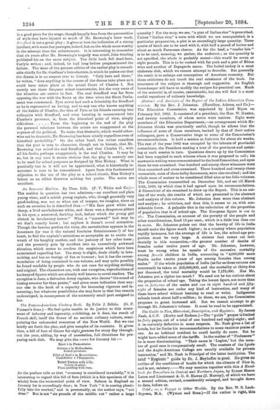Abstract and Analysis of the Report of the Indian. Education
Corn. mission. By the Rev. J. Johnston. (Hamilton, Adams, and Co.)— The Education Commission was appointed by Lord Ripon On February 3rd, 1882. It consisted of a president, the Hon. W. Hunter, and twenty members, of whom seven were natives. Eight were members of the Education Department,—an arrangement which Mr. Johnston thinks was practically useful, though he allows that the influence of some of these members, backed by that of their native colleagues, gave a Conservative tinge to some of the Commission's recommendations. It held a session at Calcutta for about six weeks. The rest of the year 1882 was occupied by the labours of provincial committees, the President making a tour of the provinces and assist- ing at each session in turn. Questions drawn up by the Commission had been supplied to each witness whom it was proposed to call; his answers in writing were communicated to the local Committee, and upon them he was examined. One hundred and ninety-three witnesses were thus examined and cross-examined. Three hundred and twenty-three memorials, most of them bulkydocaments, were also received ; and the whole mass of matter to be considered filled nine or ten folio volumes. The Commission reassembled on December 5th, and sat till March 16th, 1883, by which time it had agreed upon its recommendations. A Committee of six remained to draw up the Report. This is an out- line of the work, the results of which are presented in the abstract and analysis of this volume. Mr. Johnston does more than abstract and analyse ; he criticises, and does this, it seems to us, with con- siderable force. A palpable blot is the calculation of the proportion of population that is of school age. The European figure is one in six. The Commission, on account of the poverty of the people and other considerations, fixed 15 per cent., which is a little less than one in seven. Mr. Johnston points out that the brevity of life in India should make the figure mach higher ; in a country where population rapidly increases, but the average of life is low, the school-age pro- portion must be very large. A sinister fact comes out inci- dentally in this connection,—the greater number of deaths of females under twelve years of age. Mr. Johnston, however, must be wrong when he speaks of the excessive mortality among female children in India, amounting to "4000,000 more deaths under twelve years of age among females than among males." If the whole population of India (as far as these returns are concerned) be taken at 205,000,000, and the mortality at thirty-five per thousand, the total mortality would be 7,175,000. Has Mr. Johnston put a cipher too much ? We need not be too curfew about the proportion of school age. Taking the lowest figure, not more than one in forty-two of the males and one in eight hundred and fifty- eight of females are under any kind of instruction, and many of these leave school without learning to read or write. Indigenous schools teach about half-a-million ; to these, we see, the Commission proposes to grant increased aid. But we cannot attempt to go through Mr. Johnston's volume. It must be read to be appreciated.


































 Previous page
Previous page